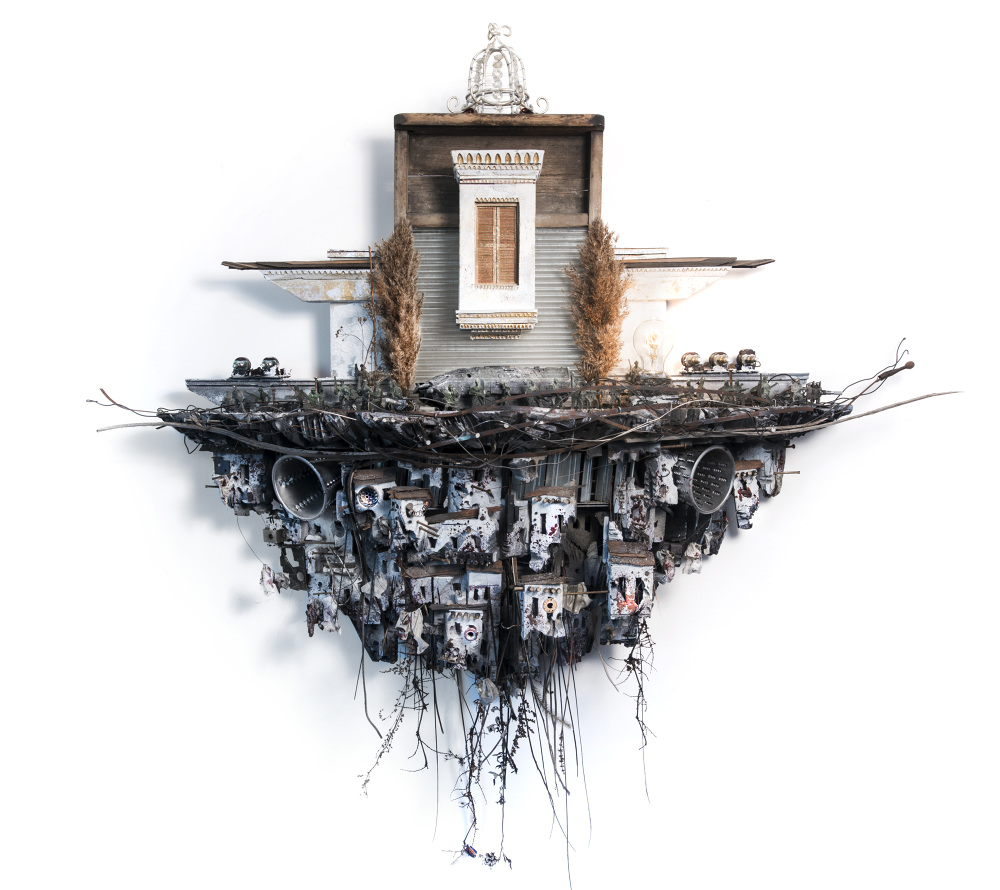
By Allison Chen
[divider]
[dropcap]C[/dropcap]ollege students from all backgrounds experience nostalgia and the pain of leaving our beloved hometowns. However, while most of us have the liberty of returning home, some—like Syrian artist and architect Mohamad Hafez—are refugees, no longer able to go home, unable to bring anything with them but a few belongings and memories of their pasts.
Critical Refuge, a collection of sculptures by Hafez, explores the political and spiritual concepts of “refuge”—which entails both a physical safe haven from sociopolitical conflict and a space for artistic meditation. The sculptures are inspired by contemporary, urban Syrian landscapes, with threads of his family’s migration stories woven through them. The narratives of this exhibition include his personal journey, postcolonial histories and aftermaths, reflective memories, and media depictions of the Syrian refugee crisis.
In “Towards Sketching a Life: Biographies of and conversations with Mohamad Hafez,” Hafez explains that the United States government enforced the travel ban against Syrians while he was living in the U.S., ensuring that he “couldn’t go home for eight years.”
“My friends who went back to visit their parents, never came back…This pain is what sparked my artwork. One night I just started making facades and something clicked,” Hafez narrates.
On display in the Whitney Humanities Center until December 20th, the sculptures reside in a large, rectangular room, preceded by a hallway filled with sizeable photographs taken by Julia Rooney, illustrating Hafez’s artistic “refuge”—his Westville studio. The first few photographs depict Hafez’s creative materials; another shows Hafez standing in the doorway of his studio, documental photos of Syria lining the top of the doorway—a newspaper reading “U.S. Hits Syria” next to the light switch. The last photo represents Hafez working in his studio, evoking the sense of safety the artist feels within this place.
Walking directly into the spacious room, the viewer encounters the first sculpture to the left, which is His Royal Highness, made of plaster, paint, rusted metal. The center features gold metal resembling speakers and pipes that extend outward. These metal bits are surrounded by drab, gray pieces of plaster, highlighting a significant contrast between the shininess of the center and disorder of the outer artistic parts. The digital program explains that the piece “conveys dictatorship as a technology with moving gears and transmitting parts,” indicating that only the throne’s power remains potent—everything else may move around.
In a different style than the other pieces, Mama… I Don’t Know How to Swim features origami boats of lined paper strung from the ceiling on fishing wire and metal hooks. Hafez created the boats with the help of newly arrived refugee families and their children in New Haven, CT. According to the digital program, the boats symbolize migrant deaths in the attempts to cross the Mediterranean Sea in 2014-2016.
The sculpture questions the 1951 United Nations Refugee Convention’s description of a refugee as an individual existing “outside the country of his nationality,” suggesting that it is impossible to fit so many people attempting to flee their countries in such a narrow legal definition. The digital program explains that the orderly lines of the paper boats provide a contrast to the western media’s characterization of the refugee crisis as “disorderly” and a “problem.”
Not only does Hafez examine complex layers of the refugee crisis, but he also portrays the consequences of victory in a multidimensional manner, examining what “victory” may look like in Syria today. We Have Won! utilizes scraps of plaster and paint to create what looks like a downtrodden living space, with chaos, disarray and ripped seams to illustrate how military victory will inevitably leave destruction and desolation to the homes of others. According to the program, this is Hafez’s statement on the aftermath of “military proxies of interventionist coalitions” in the process of “claiming victory in the context of Syria.”
Hafez touches upon a variety of themes and motifs of loss, memory, hope, and anger in Critical Refuge. With today’s ever-relevant questions of the refugee crisis and how nations may offer asylum to those fleeing torn countries, his work may resonate not only with those who may have permanently lost their homes but also with those who desire to work toward aiding those refugees or displaced persons.
On a personal level, however, I felt the exhibit touched on universal feelings of private longings and wishful glances toward the romantic past. While I romanticize the thought of visiting my hometown, I acknowledge that that hometown exists for me to return. As I felt the stories of displacement through Hafez’s work, the depictions of hometowns compound that evocative sensation of loss.
It is both an analysis of the tense issues that surround the refugee crisis and a requiem for lost innocence and lost homes.
[hr]
Allison Chen is a first year at Timothy Dwight College. You can contact her at allison.chen@yale.edu.